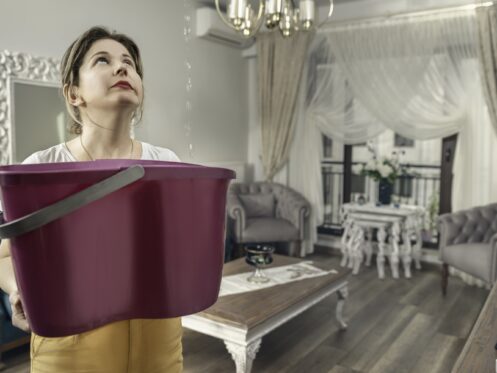Having a plumbing leak at your home might not seem like a big deal. After all, how much damage can some small drops of water do? You may be surprised. These tiny drops can cause considerable damage, ranging from putting your health at risk to making you pay significant amounts of money on monthly bills and repairs. Understanding the signs of a potential plumbing leak can help you catch and fix the issue sooner rather than later while the problem worsens.
1. Increasing Water Bills
Unless you’re new to your home, you’ll know how much your water bill should be each month and how it can fluctuate throughout the seasons, depending on how much water you use. If nothing has changed from your normal routine, but you’re seeing an increase in your water bill, it could be a sign of a leak somewhere in your water delivery system. The worse the leak gets, the higher your water bills will be.
You can troubleshoot whether your water meter is running when everything in your home is shut off. When all fixtures are closed and no appliances (like your refrigerator icemaker) are drawing water, your faucets are all off and your toilets are not running, take a picture of your meter. Leave everything off for 30 minutes and come back to see if the number has moved. If you have a manual meter with spinning numbers, you can use the picture to compare whether there has been a small change in position in that time. This suggests a hairline leak.
2. Unexplainable Dampness
Dampness can be surprisingly easy to overlook at your home. For example, if the dampness is under your bathroom sink or kitchen sink, you might chalk it up to the fact that you or someone else accidentally splashed some water while you were reaching for an item in the cabinet or from washing your hands. If the issue happens once, it might not be a big deal.
However, if you keep checking and notice that it’s repeatedly happening or continues to be damp without a break, it’s time to call a plumber to evaluate the situation. Check for a leak, but even if you don’t see one while you’re running the water, don’t assume there’s not one present. It may be hidden where you won’t be able to spot it.
3. Visible Mold Growth
Mold grows incredibly fast, and within a day or two, you can have the makings of a major problem at your home. Frequent checks underneath your sinks and around your showers can allow you to spot it easily because you’re often in those areas. However, the real problem lies in areas where you don’t typically go. Often, your only early sign of mold growth is an odor.
For example, you could get a plumbing leak in a basement storage area, behind your washing machine, or around your water heater. Mold can grow rapidly and spread before anyone notices it. Check likely areas regularly to be sure mold and mildew aren’t growing behind appliances and other easy-to-forget spot.
4. Pools of Water
A pool of water in a surprising location often indicates a leak. This may be a plumbing leak, but it can also result from a roof leak or a condensation leak in a refrigerator or HVAC system. To troubleshoot the source of puddles of water, look at whether there is an appliance in the vicinity that could be the culprit and whether the puddles appear when there has not been rain or snow. Look for signs of water on the ceiling where the puddle could have dripped. Check for damp places on the drywall near the puddle if it’s close to a wall. Feel dampness on the floor or cracks where the water could rise. Smell the water to see if you can detect the odor of wastewater. Use this information to call the right plumbing services professional to address it. If you’re uncertain, you can ask a plumber to help decide whether the water is caused by leaky pipes or something else.
5. Dripping Noises
If you hear dripping water noises when you’re not supposed to, start by tracking down the most likely locations of the sound. Check all the sinks and showers to see if it’s just a matter of one or more faucets not being turned off all the way. Next, check underneath the sinks. If those don’t seem to be the source of the drip sounds, check all your other water-using appliances, such as your water heater, dishwasher, and washing machine.
Once you’ve checked everywhere and still can’t find the source, go back and put a couple of sheets of paper towels underneath each sink, turn the faucet on for a few seconds, and then turn it off and move on to the next sink. Give it an hour; then, check to see if any paper towels have drip marks. This can help you determine if the issue stems from a sink or if the drips come from elsewhere.
If you suspect that the drips are behind a wall, a plumber will use special acoustic equipment to help pinpoint the source. This helps them minimize the number and size of holes necessary to examine the problem more closely and perform repair work.
6. Visible Water Stains
Unfortunately, spotting a water stain on your ceiling is never good. This typically means a leak somewhere, possibly from your plumbing system. Check if you can safely see where the water is coming from. Again, check for other causes, like water coming down on rainy days due to a leaky roof. If the problem isn’t occurring due to a singular issue like a sink that accidentally overflowed, you need to call a plumber right away. A damp ceiling can collapse if it gets wet enough. It’s also a recipe for mold growth.
7. Low Water Pressure
If you’re experiencing low water pressure in one or more parts of your home, it might indicate a leak. The first thing you should do is check all the sinks and showers to see if the issue is with just one or with more than one or all of them. While checking each sink, take a peek underneath and see if you notice signs of a leak, such as the previously mentioned wet spots.
Contact a Plumber
Whether or not you find the source of the leak, it’s ideal to call a plumber if you notice visible signs so that they can search for it and fix the issue. Let them know what you’re experiencing and if you think you know where the leak is. Regarding odors, they’ll inspect your plumbing and see if the smells are due to a plumbing issue, such as a leak, or if it might be due to abnormally high humidity levels or another problem.
Ask the plumber if you should take precautions, such as shutting off the water to your home. This can sometimes save diagnostic time.
Don’t let leaky pipes take over your home. Contact Air Control Home Services in Lake Havasu City, AZ to have one of our qualified plumbers diagnose the issue and suggest a solution, whether it’s a pipe repair or having brand-new pipes installed. We also provide various additional plumbing services, including water heater replacement, drain cleaning, tankless water heater installation, and pipe repair. Our team is available seven days a week for assistance with HVAC and electrical issues as well.






